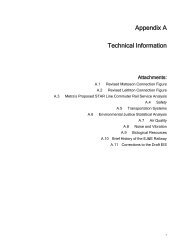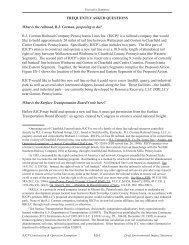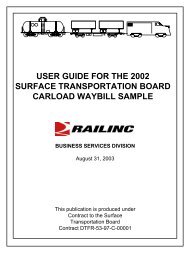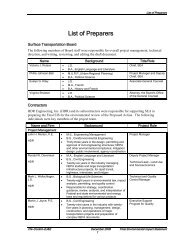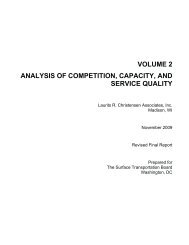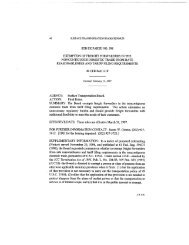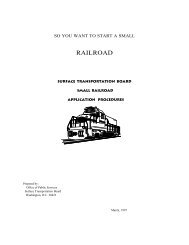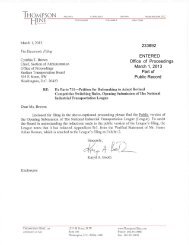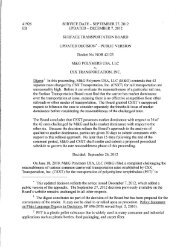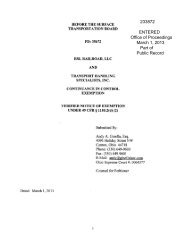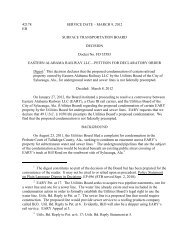Norfolk Southern/Conrail Rail ConnectionâBucyrus, Ohio - Surface ...
Norfolk Southern/Conrail Rail ConnectionâBucyrus, Ohio - Surface ...
Norfolk Southern/Conrail Rail ConnectionâBucyrus, Ohio - Surface ...
You also want an ePaper? Increase the reach of your titles
YUMPU automatically turns print PDFs into web optimized ePapers that Google loves.
Floodplain<br />
FEMA maps for the area show that the proposed project is not within the 100-year floodplain.<br />
Groundwater<br />
Groundwater quality could only be affected if a sufficient amount of a contaminant from a potential spill<br />
were released and if it were able to leach to the aquifer prior to implementation and completion of cleanup<br />
procedures. The circumstances under which this could happen would be unusual considering the<br />
permeability of the soils (moderately slow to slow), the depth to groundwater (30 to 60 feet), low rail<br />
traffic (eight trains per day), low rail speed (25 mph), and NS’ transportation safety performance record<br />
and emergency action procedures. The probability of a train accident on the proposed connection is<br />
approximately 1.93 accidents per million train miles, or one accident every 300 years (The FRA defines<br />
a train accident as any event resulting in damages as low as $6,300). Response to a contaminant release<br />
is expected to be timely and sufficient to clean up the release. Any spill or contaminant release would<br />
be reported and cleaned up in accordance with all Federal and state statutes and regulations. The<br />
construction of the proposed rail line would not have adverse impacts on groundwater resources. Only<br />
a small amount of fuel and oil would be present on the site during construction activities. Therefore,<br />
any potential leaks or spills could only involve small amounts and would be cleaned up immediately.<br />
4.1.6 Biological Resources<br />
4.1.6.1 Evaluation Criteria<br />
The following significance criteria were utilized to assess the potential impacts to biological resources<br />
resulting from the proposed projects:<br />
• Loss or degradation of unique or important vegetative communities.<br />
• Harm to or loss of individuals or populations of rare, threatened or endangered plants or<br />
animals.<br />
• Disturbance of nesting, breeding or foraging areas of threatened or endangered wildlife.<br />
• Loss or degradation of areas designated as critical habitat.<br />
• Loss or degradation of wildlife sanctuaries, refuges or national, state or local parks/forests.<br />
• Alteration of movement or migration corridors for animals.<br />
• Loss of large numbers of local wildlife or their habitats.<br />
Sensitive animal species with potential to occur in the vicinity of the project may be impacted by<br />
construction activities. A determination as to the level of impact will depend on many factors including<br />
the availability of suitable habitat, previous surveys, and comments from agencies.<br />
Parks, forest preserves, refuges and sanctuaries were identified within one mile of the proposed<br />
construction. Potential impacts to these areas were determined based on their distance from the<br />
proposed constructions and the degree to which rail construction, operation and maintenance would<br />
disturb or disrupt activities at these areas.<br />
4-7




